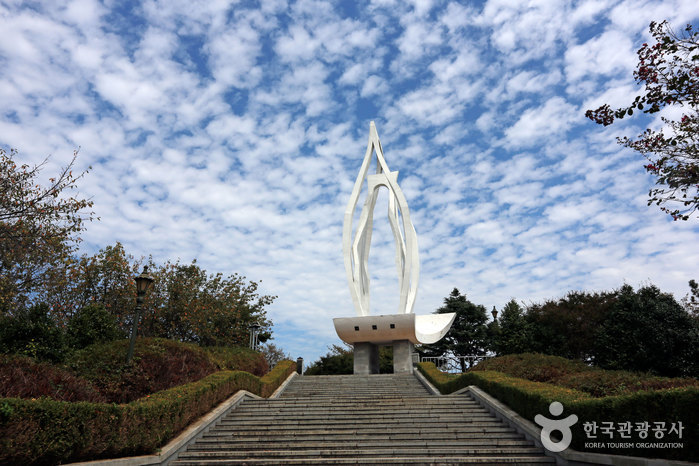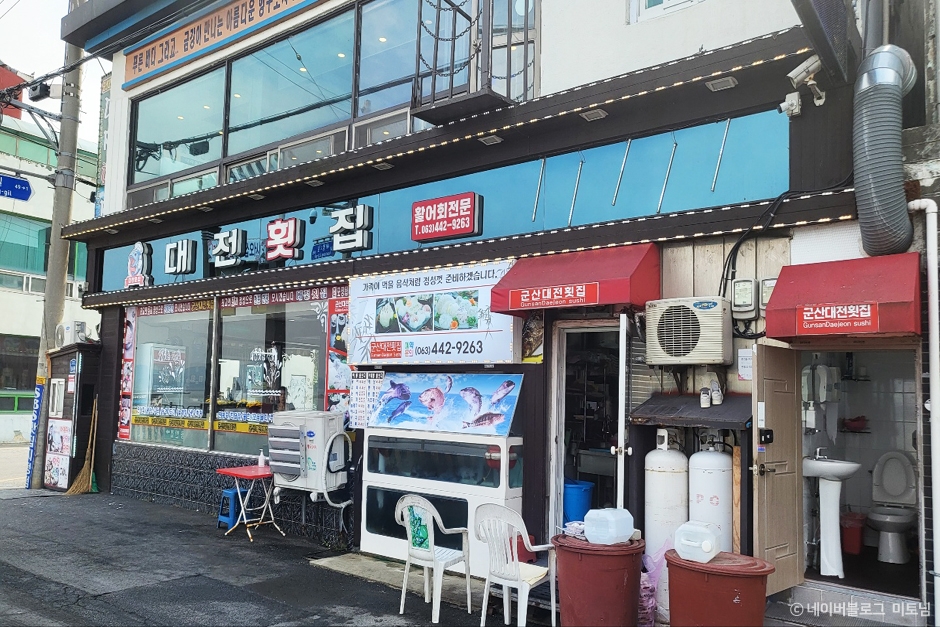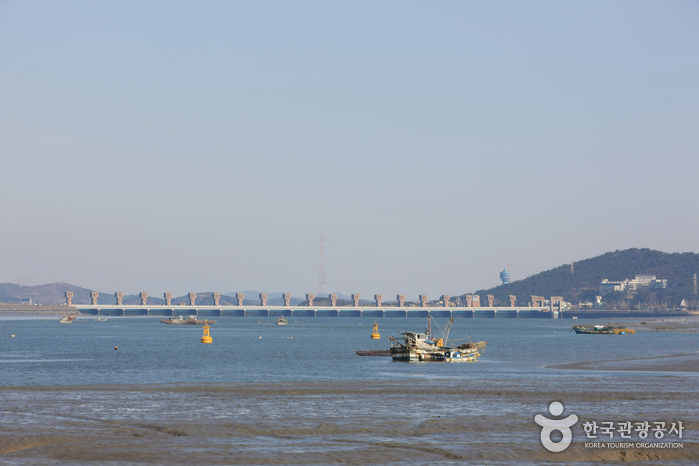Japanese-style House in Sinheung-dong (Hirotsu House) (군산 신흥동 일본식가옥(히로쓰 가옥))
13.5 Km 42128 2024-04-07
17, Guyeong 1-gil, Gunsan-si, Jeonbuk-do
+82-63-454-3315
Japanese-style House in Sinheung-dong was designated as Registered Cultural Heritage in 2005. The area of Sinheung-dong, where the Hirotsu House is located, was a residential area for the wealthy class during the Japanese occupation period. The house is named after Hirotsu, the man who built the house.
Several Korean movies and dramas such as "The General’s Son (1990)," Fighter in the Wind (2004)," and "Tazza: The High Rollers (2006)" were filmed in this house. The house is a typical Japanese two-story timber house, keeping the original forms of its roof, outer walls, inside area and the Japanese-style garden which has significant meaning in regards to the architecture history.
Chowon Photo Studio (초원사진관)
13.5 Km 0 2024-04-07
12-1, Guyeong 2-gil, Gunsan-si, Jeonbuk-do
Gunsan Chowon Photo Studio is famous as the filming location of the movie, “Christmas in August” starring actors Han Suk-kyu and Shim Eun-ha. The movie depicts unfulfilled love between photographer Jung-won (Han Suk-kyu) who lives a time-limited life with his father and parking enforcement agent Da-rim (Shim Eun-ha) who appears in front of Jung-won one day. A majority of the movie was filmed at Chowon Photo Studio in Wolmyeong-dong, Gunsan-si. At the time of the production of the film, the “Christmas in August” production crew decided not to shoot in an indoor set but, instead, searched photo studios across the country; however, they failed to find the right location. Then, one day, when they went into a cafe for a quick break, they found a garage with a shadow of a summer tree outside the window and, after getting permission from the owner, converted it into a photo studio. The name “Chowon Photo Studio” was proposed by the lead actor, Han Suk-kyu, who named it after a neighborhood photo studio near his childhood home. After the filming was completed, Chowon Photo Studio was torn down as promised with the owner but was later restored by the city of Gunsan, and it is now open free of charge to everyone who visits Gunsan. It still exhibits the cameras, fans and albums that appeared in the movie and, after tourists take photos here, the studio managers send their photos by email.
Gunsan Port (군산항)
13.5 Km 39526 2024-04-07
442 Imhae-ro, Gunsan-si, Jeonbuk-do
Gunsan Port, established in 1899, is the port of Gunsan. During the Japanese colonial period, Gunsan prospered as a trading port. Modern buildings from that era still remain around Gunsan Port, creating a nostalgic atmosphere often referred to as a "time-travel village." Nearby attractions include the Gunsan Modern History Museum and the Sinheung-dong Japanese-style House Street.
Gunsan Modern History Museum (군산근대역사박물관)
13.6 Km 24722 2024-04-06
240, Haemang-ro, Gunsan-si, Jeonbuk-do
The Gunsan Modern History Museum covers the history of Gunsan's transformative role as an international trading port. The museum exhibits past images of Gunsan, showing the city's rise and importance as a West Sea maritime distribution port.
Guesthouse Yeojeong [Korea Quality] / 게스트하우스 여정 [한국관광 품질인증]
13.6 Km 247 2024-04-07
25 , Guyeong 2-gil, Gunsan-si, Jeonbuk-do
+82-10-8098-2202
Guesthouse Yeojeong (‘Journey’) stands on Modern Culture Street in Gunsan, Jeollabuk-do, and offers two types of accomodation: Korean-style ondol-heated rooms and a room with wooden bunk beds. The owner lives on the first floor and takes good care of the guests. In the common living room, there are books, music, and photos and paintings of Gunsan from the 1920s and 1930s - giving it a bohemian feel. A simple breakfast of toast, eggs, coffee and fruit is provided. Tourist attractions such as Chowon Photo Studio, Iseongdang Cafe, and Dongguksa Temple are all reachable on foot.
Surawon (수라원)
13.9 Km 21068 2024-02-26
641-9, Jangsan-ro, Janghang-eup, Seocheon-gun, Chungcheongnam-do
0507-1435-6250
Surawon is a hanu (Korean beef) and bulgogi restaurant located at the estuary where the Geumgang River meets the Yellow Sea, allowing visitors to have a great view of the sea, the river, tidal flats, and the city of Gunsan beyond the river. The menu includes seoksoe bulgogi (grilled bulgogi), dwaeji galbi jjim (braised pork galbi), so galbi jjim (braised beef galbi), and hanu gui (grilled Korean beef). The nearby Geumgang Estuary Embankment is famous for the view of thousands of migratory birds dancing above the water, while the city of Gunsan across the Dongbaekdaegyo Bridge is known for its modern architecture and historical sites.
Wolmyeong Park (월명공원)
14.0 Km 9007 2024-04-07
26-3, Wolmyeonggongwon 1-gil, Gunsan-si, Jeonbuk-do
+82-63-450-4000
Wolmyeong Park is a popular tourist destination in Gunsan and
connects five mountains in the vicinity. The park has 12 kilometers of walking trails, as well as an observatory, sculpture park, and various monuments. From Susi Tower, which resembles a flame or wind-blown sail, people can see all of downtown Gunsan, the sea to the south of Gunsan, the mouth of the Geumgang River, and the large Janghang smelting factory.
The park has well-arranged gardens and 30-year old rattan and cherry trees. A cherry blossom photo contest is held every April, when the park is covered in cherry blossoms.
Gunsan Daejeon Hoetjib (군산대전횟집)
14.0 Km 1 2024-04-07
149 Naehang 2-gil, Gunsan-si, Jeonbuk-do
Gunsan Daejeon Hoetjib is a popular local recommendation known for its fresh sliced raw fish and upscale side dishes. Located just a 10-minute drive from Gunsan Port, customers can enjoy their meal while admiring the view of Dongbaekdaegyo Bridge and the inner harbor of Gunsan. The signature menu item is the modeum hoe (assorted sliced raw fish) featuring a variety of fish such as flatfish, rockfish, sea bass, and sea bream, along with steamed lobster.
Gunsan Geumgang Estuary Bank (금강하구둑(군산))
14.5 Km 39486 2024-04-07
120, Cheolsae-ro, Gunsan-si, Jeonbuk-do
+82-63-454-3353
Geumgang Estuary Bank was completed in 1990 as part of an agricultural development project for 6 cities and counties in Chungcheongnam-do and Jeollabuk-do. The Korea Agricultural and Rural Infrastructure Corporation invested approximately 100 billion won for the project and the construction lasted for 8 years. The estuary bank can hold up to 130 million tons of water. The 1,840-meter long bank serves a bridge that connects Chungcheongnam-do to Jeollabuk-do.
Aside from being the source of water for agricultural and industrial use in Jeollabuk-do and Chungcheongnam-do, the bank also provides flood control for the area around Geumgang River. It helps keep Gunsanhang Port operational by preventing soil
and sand from accumulating at the mouth of the river. It also prevents the backwash of seawater from causing damage to farmlands. Geumgang Estuary Bank has an important role as a tourist destination by connecting Gunsan and Janghang.
Deoksugung Haemul Kalguksu (덕수궁해물칼국수)
15.1 Km 20616 2024-02-28
5, Jangsan-ro 855beon-gil, Maseo-myeon, Seocheon-gun, Chungcheongnam-do
041-956-7066
Located near the Geumgang Estuary Embankment, Deoksugung Haemul Kalguksu serves haemul kalguksku (noodle soup with seafood) full of clams and vegetables. Kalguksu (noodle soup) is made by rolling out a thin flour dough, slicing it into thin strips, and then boiling them in a soup. There’s a variety of kalguksu (noodle soup) dishes on offer, along with wangmandu (jumbo mandu). The broth is clean, thanks to shrimp and fresh vegetables. Don’t miss yeolmu kimchi (young summer radish kimchi), which is served as a side dish in the restaurant and goes perfectly with kalguksu (noodle soup).

![Guesthouse Yeojeong [Korea Quality] / 게스트하우스 여정 [한국관광 품질인증]](http://tong.visitkorea.or.kr/cms/resource/12/2652012_image2_1.jpg)



 English
English
 한국어
한국어 日本語
日本語 中文(简体)
中文(简体) Deutsch
Deutsch Français
Français Español
Español Русский
Русский